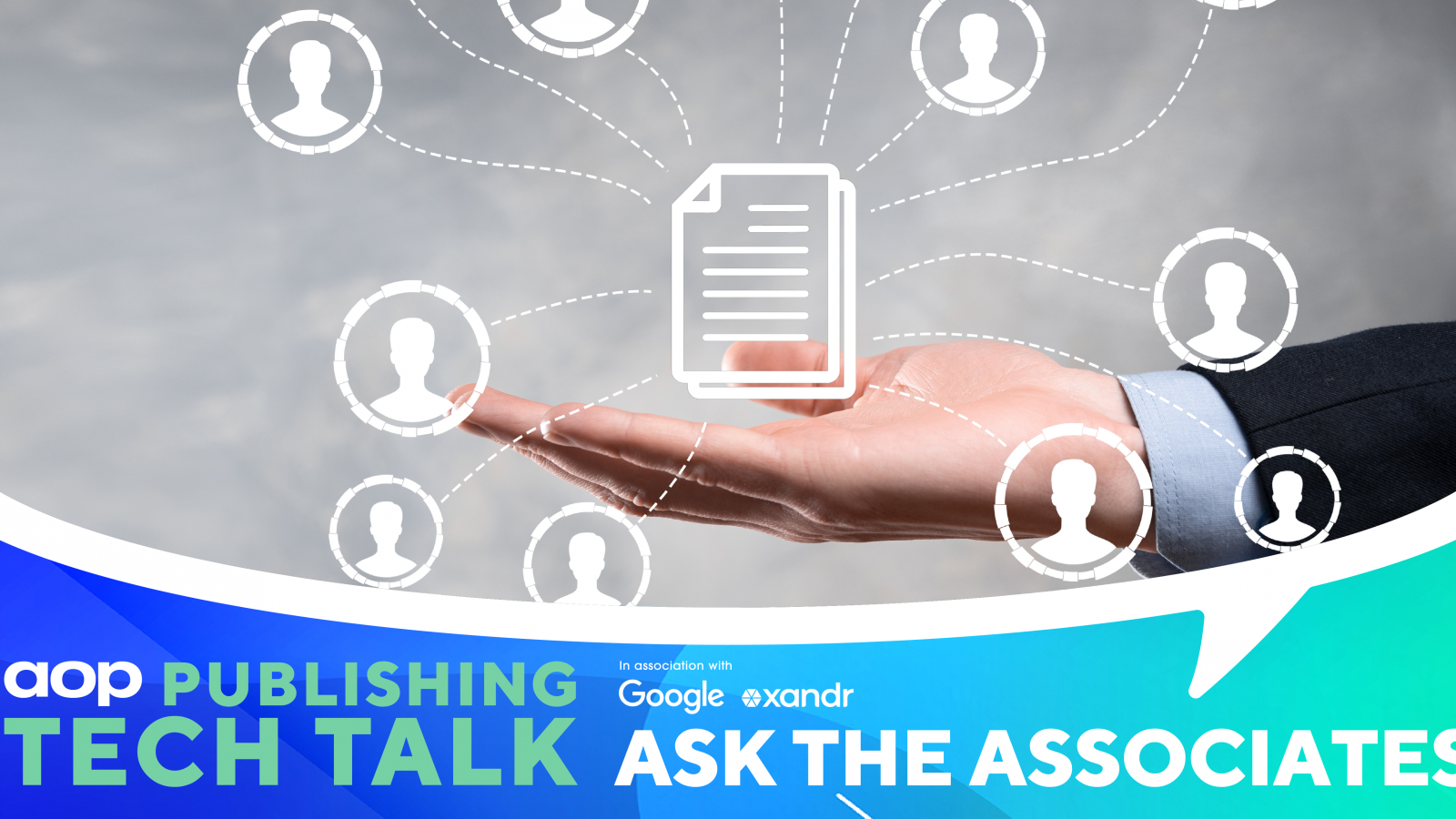
Seven strategies for publishers looking to take control of their first-party data
Published: 08 Oct 2021
Data is one of a publisher’s most valuable assets. And although the cookie has been granted a short lease of life, the focus remains very much on identifying a replacement for third-party cookies. The wealth of first-party data at your fingertips, as a publisher, creates a huge opportunity to take back control – but what will be key to building long-term success? For the first day of the AOP Publishing Tech Talk, we reached out to our expert Associates to hear their top tips to help publishers take control of their first-party data in a post-cookie world…
New identifiers need to be developed to enable marketers to target programmatically.
Publishers are the new gatekeepers of consumer identity and are therefore accountable for maintaining privacy standards and ensuring their users’ choices are respected. To keep control of their first-party data, they should be looking to establish persistent identifiers that are not tied to third-party cookies, via email logins or first-party cookies. As the value of first-party data increases, publishers must make sure they pass this identifier in on the ad request so it can be targeted by marketers programmatically.
It is essential that publishers evaluate their tech stack and tech partners to ensure they understand exactly how their identifiers are being consumed and shared across the supply chain. Most importantly, publishers need to consider how tech partners store identifiers, whether their identifiers are being mapped to others, and what controls exist over additional partners having access to them.
Harvin Gupta, Solutions Engineering Senior Director, Xandr
Shift to a Personified Advertising strategy to secure long-term success
In a market where most publishers are looking to monetize an increasing number of consent-less impressions and with increasing pressure on GDPR and privacy enforcement, the future belongs to publishers who will find ways to maintain their revenues without collecting PII (Personally identifiable information). This future must be anticipated right now, and our industry should stop holding on to the old ways. The main focus for publishers should be to find solutions that do not rely on cookies or IDs, that are still able to qualify 100% of their inventory. We believe that an efficient way to do so is with personification, which has grown significantly since the changes to cookies and IDFA were announced. The concept of Personified Advertising relies on audience interest data to qualify impressions rather than personal data to qualify users.
Fabien Magalon, Chief Supply Officer, Ogury
Understand that being entrusted with someone’s identity is a privilege – and should be treated as such.
Get users to identify themselves with phone/email, through smart registration and/or paywalls. Identity is the building block on which most data revenue is based. Also, treat identity as an important asset you need to protect, both for consumers and their right to privacy but also for your own ability to make money long term.
Stian Remaad, CEO, Adnuntius
A relationship involves a give and a take – what are you offering in return for your audience’s data?
As the market shifts away from third-party tracking approaches, having a first-party data strategy will be crucial for publishers to take back control in a post-cookie world. To collect first-party data they need to prioritize consumer privacy, build trust with their customers, and put the customer experience first. To be comfortable with publishers collecting their data consumers need to both trust the publisher as well as feel like they’re getting something in return - exclusive content usually is a good start. Companies like ITV, Channel 4 and The Telegraph already have impressive first-party data strategies in place and are able to collaborate with advertisers in a privacy-first and future-proof way.
For the first time publishers have full control over their own assets and can build closer and more effective collaborative relationships with advertisers, and actually define those relationships.
Stuart Colman, VP of Sales, InfoSum
The value exchange of advertising is changing – and it’s creating new opportunities for profitable collaborations.
The deprecation of third-party cookies is a huge opportunity for publishers to leverage privacy-first, first-party authentications to take back control of the ad buying process, build more profitable collaborations with marketers and remind brands about the value of working directly with premium publishers. It’s about resetting the value exchange of advertising to create a more direct business between the reader, the advertiser, and the publisher.
Ryan Afshar, Head of Publishers, UK, LiveRamp
Consent is obviously critical, but publishers should also begin moving towards a contextual offering.
I believe there are actually two things required for publishers in order to unlock opportunities in a post-third-party cookie world.
Every website will probably build a cookie-wall with their CMP in order to get the consent from the user. Currently around 20% of users are not consenting. What happens if you don't have consent? No cookie, no frequency capping, no user targeting, no conversion tracking and no segment audiences are allowed.
In the meantime, I believe that we will probably move from a user-based experience to a contextual offering. As a result, publishers should probably start building their contextual offering based on key values sent from the page. However, in the near future, Industry ID solutions (LiveRamp, NetID, ID5, etc) will probably grow in order to have a smooth transition between user-based and contextual data.
Loïc Pagny, Senior Technical Account Manager, Pubstack
Publishers should seize the opportunity to decrease their reliance on Google.
It’s clear that publishers and brands will need more than a single approach to delivering relevant, appropriately-targeted advertising in the post-cookie era. Of course, taking control starts with asking users to register in order to capture first-party data. Beyond that, it’s essential to identify technology and strategic partners who understand and can help execute a multi-faceted strategy that works across anonymous and known users, direct and programmatic advertising, the Google and open web ecosystems. Doing that will have immediate value, unlocking opportunity with the sizable share of the audience that’s already browsing without third-party cookies.
Our advice to clients is to take this pause as an opportunity to develop less dependence on Google and its tight hold on search and digital advertising, which for publishers and brands means building direct user relationships, and diverse technology solutions for advertising and marketing.
Michael Silberman, SVP Strategy, Piano
All this week, the AOP Publishing Tech Talk is giving publishers the information download they need to grow their businesses through the creative and effective application of tech solutions.
On Day One, we’re putting the spotlight on data. Here’s how you can get involved…
- Check out this exclusive video guide from UKOM and Ipsos on how a comprehensive approach to tagging in Ipsos iris delivers real value for publishers. WATCH THE GUIDE HERE FROM 10AM.
- What’s next for data privacy? Our Managing Director, Richard Reeves, speaks with Christie Dennehy-Neil of the IAB and Konrad Shek of the Advertising Association to discuss responses to the current DCMS consultation on data reform and explore future data strategies for publishers. LISTEN TO THE PODCAST HERE FROM 11AM.
- Join our premium sponsors for the day, Xandr, as they join some of the most ambitious and forward-thinking publishers across Europe to share new approaches to navigating the programmatic privacy shift. REGISTER TO WATCH THE LIVE WEBINAR FROM 2-3PM TODAY.
Or check out everything we have planned for the rest of the week HERE!
Categories: Ask the Associates



